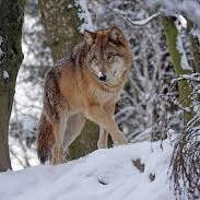 |
Mongolian wolf |
|
He is a wild animal |
Origin |
Mongolia | |
Translation |
Francis Vandersteen |
| The possession of this animal is not authorized Royal Decree establishing the list of mammals not kept for production purposes that may be kept (M.B. 24.08.2009) |
| The Mongolian wolf (Canis lupus chanco) is a subspecies of the gray wolf, native to Mongolia, northern and central China, Korea, and the Ussuri region of Russia. The Mongolian wolf is a carnivorous animal. When in a pack, it can attack very large prey such as goitered gazelles, elaphe deer or sheep, but generally only weak, sick or wounded individuals. It is equally content with small prey such as chipmunks, pikas or marmots. The Mongolian wolf's range includes Mongolia1 , northern and central China, Korea, and the Ussuri region of Russia, from where they have colonized northern China more recently, due to human settlement and the retreat of their tiger competitors. Their range is limited to the east by the Altai/Tien Shan mountains, beyond which Mongolian wolves are found, and to the south by the Tibetan plateau, and in southern China by another wolf species. In Mongolia, the wolf is considered an animal spirit, while the dog is considered a family member. Mongolians are not afraid of the wolf and understand that it is afraid of man. He is sometimes called the sheep murderer. According to legend, the first father of Mongolian herders was a wolf, from whom they are all descended, and yet it is necessary for them to kill wolves to protect their flocks of sheep. Some Mongolian herders acknowledge that wolves only kill weak animals, thus preserving the health of their flocks. In the traditions of the nomadic Mongols, they call the wolf the sheep's doctor. The fur is tawny, longer on the back, stiff, with a mixture of black and grey hairs, the throat, chest, belly and inside of the legs are pure white, the head is pale grey-brown, the forehead greying with short black and grey hairs. The skull is very similar, and has the same dentition as the European wolf (C. lupus). The animal is very similar to the common wolf, but shorter-legged, with short tawny hairs on the ears, flanks and outside of the limbs. Head and body length are 110 cm, tail 38 cm. |






 English (United Kingdom)
English (United Kingdom)